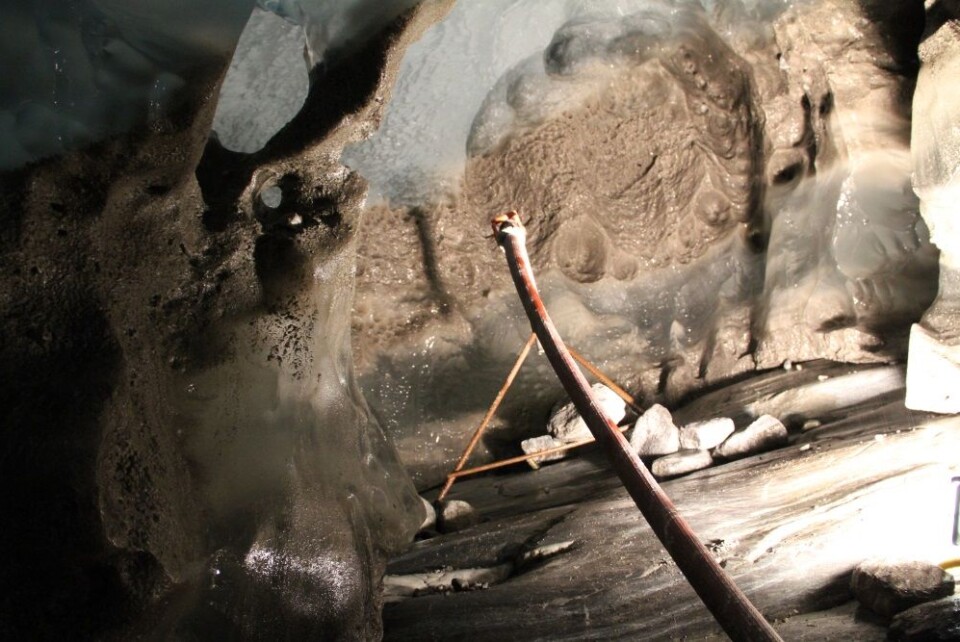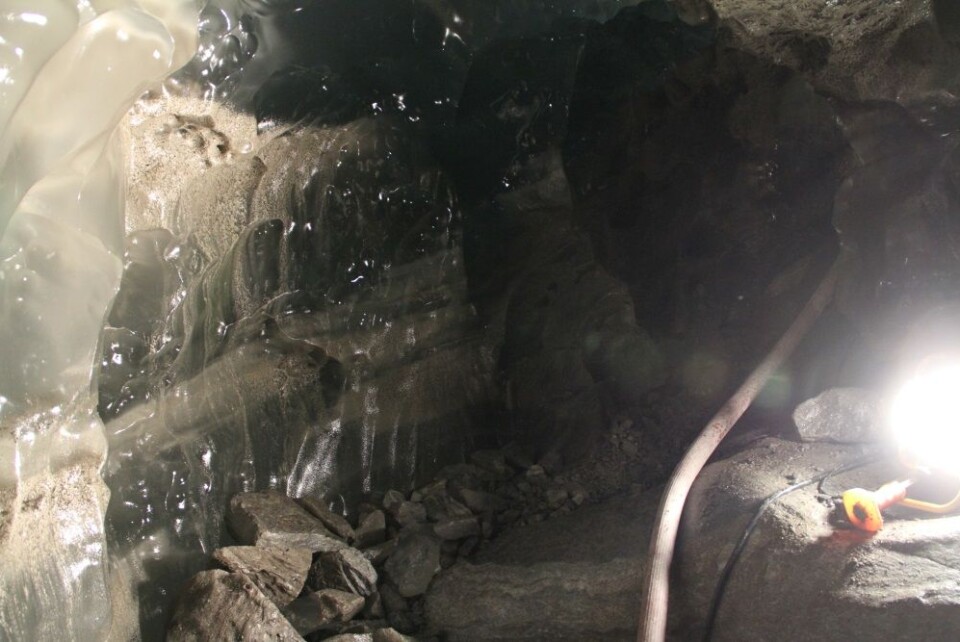A visit to Brelabben by someone who has no place being there
Denne artikkelen er over ti år gammel og kan inneholde utdatert informasjon.

Brelabben, April 2013. By Erik Rose Johnsen, communication advisor at NVE
Midnight. I’m about to start my 6 hour shift melting ice beneath the glacier Engabreen. To be where I am, I had to walk almost 1, 5 kilometers through a tunnel in the mountain. Fortunately, it is a tunnel of the big type, not the small claustrophobic one. Not claustrophobic like the place I am standing right now. At the bottom, or rather underneath Engabreen glacier, with 200 meters of ice above my head. Time to start smelting the ice.
Day zero
I started the trip to Engabreen, my first one, on a Monday afternoon with a delayed flight from Gardermoen. So far you might say that is was business as usual. Half asleep at the airport I received a text message from Alister Doyle, a reporter from Reuters who was coming along, explaining that his flight was also delayed and he had no means to get to Saltstraumen, our meeting point. I turned out his flight would land just 30 minutes after mine, so I would wait for him at Bodø airport.
From Bodø I rented a car and we drove the 30 kilometers to Saltstraumen hotel, where we had planned to meet Dr. Miriam Jackson. Her plane was also delayed, so no meet up that evening.
Day 1
Tuesday morning we got up early and left to to pick up a Danish reporter named Ib Solomon. Then on to Glomfjord to pick up the scientists whose work would take them above, and under, Engabreen.
Pierre-Marie Lefeuvre – the happy Frenchman is doing his PhD-work beneath Engabreen, while Alexandra Messerli from the University of Copenhagen is doing her PhD-work on top of Engabreen, along with friend turned field assistant, Lindsay McKay. The two of them were to install a GPS-tracking system on Engabreen, and install a camera above the glacier to capture the flow of the ice.
Also from Denmark came Sofie Vei Ugelvik, a PhD-student in Geophysics wanting to get some field experience and to get a first-hand look at Brelabben.
We had a lot of equipment and food going up to the glacier, so a heli-lift was booked for Tuesday. First off where Miriam with two technicians from Statkraft coming along to open the entrance to Brelabben, which was somehow jammed.
That turned out to be impossible. The wind proved too powerful to touch down near the entrance to Brelabben. You can not actually land near the entrance to Brelabben, as the terrain is steep. The pilot has to hover the helicopter just above ground, while the passengers get themselves and the gear out quickly.
So back to Glomfjord for lunch with the helicopter pilots.
Later that afternoon the wind dropped, making the flight possible. First of where Alexandra and Lindsay, going up above the glacier to fix a camera to a pole. Miriam came along to see if she could open the door to Brelabben, as the technicians from Statkraft had returned to their power station.
The door was still jammed, but Alexandra got her camera successfully mounted, and was picked up by the helicopter. And flown back to the rest of the group.
The back to Glomfjord for a night at the local hotel.
Day 2
An early start from Glomfjord, and the weather report looked good. The technicians from Statkraft managed to open the door, while Alexandra’s equipment was flown to Engabreen. Finally some luck!
The door to Engabreen was stuck due to a large amount of ice behind the door. Crampons were needed to walk through the initial tunnel, so yes; the amount of ice was substantial.
Pim immediately sprinted off to the laboratory and the entrance shaft of the research shaft to prepare for the melting of the tunnel, while the rest of the group was given the grand tour of the research facilities and tunnels. An impressive sight indeed. First you walk for 400 meters just to reach the living quarters, which is made up of a few barrack stacked on top of each other. It is still quite spacious, with 4 sleeping rooms, a shower a toilet and the kitchen/social area.
But no time to get familiar with the living area, because we had ice to melt!
Everybody participated in the initial work to get started, scientists and journalists alike, and we got off to a good start. This must have been around mid-day. Unless you have a watch, it is very hard to keep track of time in a place without daylight.
We then divided the whole group into 3 six-hour shifts to melt continuously for the next 24 hours. It took us something closer to 30 hours of continuous work to get the tunnel ready for the initial work to get started. 30 very wet and muddy hours.

If you don’t know anything about brelabben, here are a few facts. About 1,5 kilometers inside the mountain there is two openings allowing access to the glacier ice. One is vertical, the other one horizontal. We were melting our way into the horizontal one. Once you have melted your way into the ice, you now have about 200 meters of glacial ice above your head. It can be a bit claustrophobic for first-time visitors. The research shaft follows the bedrock, and you can melt in any direction you like. The ice moves about 8 to 10 centimeters a day, and will also close down on any open space, so you can actually see the ice cave grooving smaller from one day to the next. Once you notice that, it adds to the sense of claustrophobia.
Day 3
My first shift started at midnight with IB from Denmark. I had little sleep the previous day, but the excitement from being right where I was drove away any feeling of being sleepy. The shift was wet, very very vet. The water we spray on the ice holds 60 degrees Celsius, and it melts the ice rather fast. It also fills the air in the research shaft with steam, and the steam continuous to melt the ice everywhere. It feels like standing in a steam bath, while taking a slow shower at the same time. It might be a pleasant experience in a spa, not so much inside an ice cave. We continuously have to look for rocks in the cave ceiling. Some of them can be quite big, and it is imperative that we get them down in a controlled manner, rather than let them melt out and suddenly fall.
At the end of our shift, we were greeted with hot tea and porridge, compliments from Pim and Sofia who were taking the next shift.
Feeling very tired, and with still more work to be done, I will continue this tale of my visit to Brelabben later.







